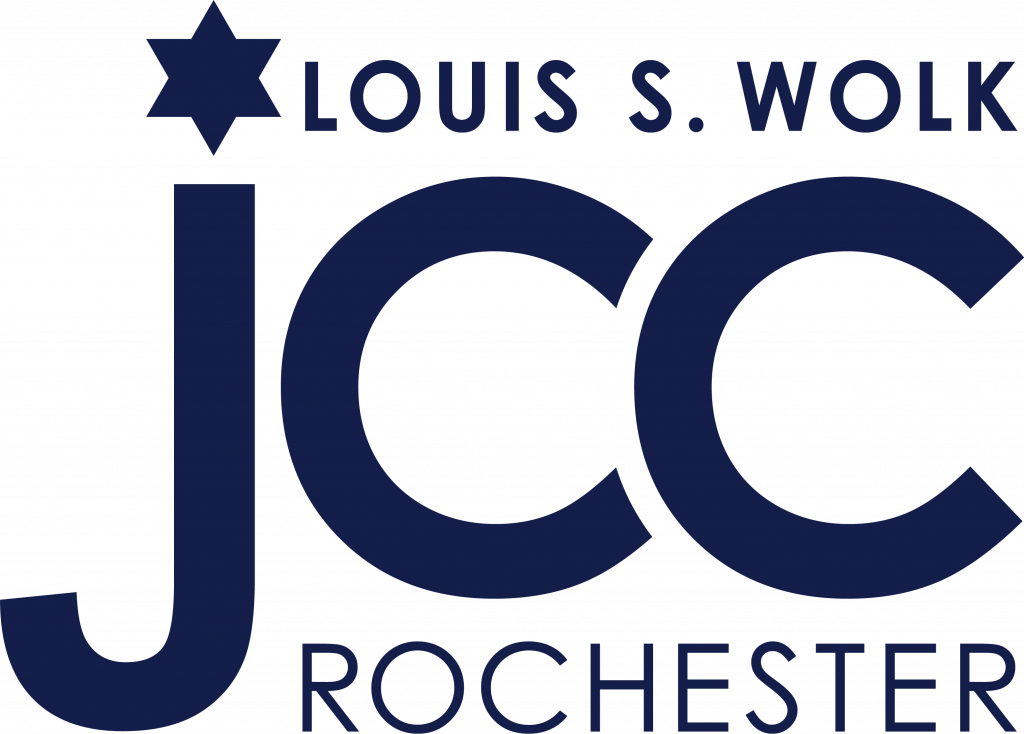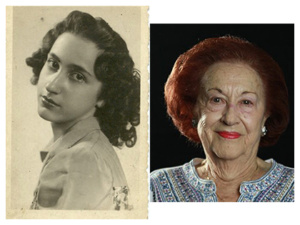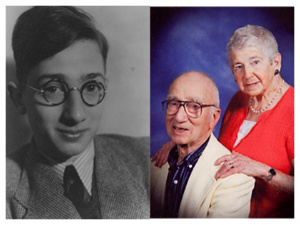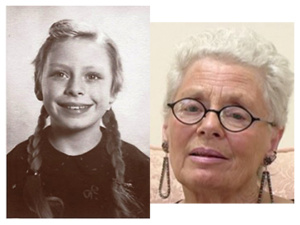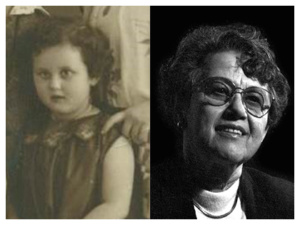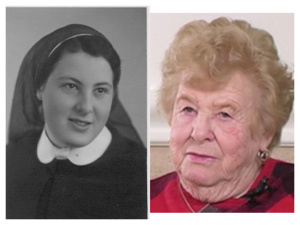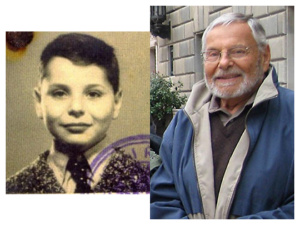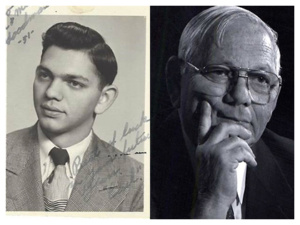
Study Guide + Educator Resources
Welcome to Survivors
Dear Educators: We are so pleased that you have made arrangements to bring Survivors, our original play about the Holocaust, to your students. For many years, Holocaust Survivors visited area schools so that our youth could understand what happens when hate becomes normalized. Now that many of those Survivors are no longer with us to share their personal experiences, we at the JCC, in consultation with the Jewish Federation of Greater Rochester’s CHAI (Center for Holocaust Awareness and Information), commissioned playwright Wendy Kout to create Survivors. Our production is based on the actual testimonies of ten actual Holocaust Survivors who ultimately relocated to Rochester, NY. Our six actors will portray all ten Survivors plus other real individuals, incorporating the verbatim accounts of the Survivors as gathered by the Rochester Holocaust Survivors Project, plus additional historical narration. Due to Covid, we are unable to perform live in person this school year, so our next best option was to add supplemental historical photos and images to a recording of our live show and present the production to your students online. We look forward to resuming live on-stage performances next year in accordance with future Covid protocols. Survivors was written to be developmentally appropriate for middle-school-aged students and above. This study guide was designed to complement the performance, and help teachers jumpstart classroom discussions and activities pertaining to the Holocaust and World War II. We sincerely hope you and your students connect with the real stories preserved through our play, and are afforded a more comprehensive view of the events surrounding a challenging time in our world’s history. Please feel free to modify the provided materials to best fit the needs of your classroom setting. If we can be of any further assistance to you, please don’t hesitate to contact us. – Ralph Meranto, Freyda Schneider and Marc CataldiTable of Contents
Survivors was produced and developed by the Louis S. Wolk Jewish Community Center of Rochester:
- Ralph Meranto, Associate Executive Director and CenterStage Artistic Director
- Freyda Schneider, TYKEs Artistic Director
- Marni Port, Survivors Tour Coordinator
- Lisa Frisone, CenterStage Managing Director
- Jason Vasquez, Chief Executive Officer
- Marc Cataldi, Company Manager
With special appreciation to the Jewish Federation of Greater Rochester/Center for Holocaust Awareness & Information:
- Sarah Walters, Jewish Federation Holocaust Education and Community Relations Program Director, who consulted on this guide
- Bonnie Abrams, CHAI Director through 2019
- Barbara Applebaum, CHAI Director, retired
- Meredith Dragon, Jewish Federation CEO
- Rose Bernstein and the Rochester Holocaust Survivors Archive
Survivor Profiles
Pre-Show Prep
Source: The United States Holocaust Memorial Museum
The Path to Nazi Genocide, Full Film (38 minutes)
The USHMM created a short film about the rise of Nazi Germany and events leading to the Holocaust. Although students may have studied the Holocaust in the past, are currently studying it, or will learn through viewing the play, this short film offers a baseline of information. This may be a useful resource to share with your students prior to the performance of Survivors, so they are familiar with terminology, general timeline, and major events.
Link to video and transcript on the United States Holocaust Museum website: https://www.ushmm.org/learn/holocaust/path-to-nazi-genocide/the-path-to-nazi-genocide/full-film
A transcript of the narration is also available.
Film Chapters
• Prologue (Starts at 00:00)
• Aftermath of World War I and the Rise of Nazism, 1918–1933 (Starts at 00:58)
• Building a National Community, 1933–1936 (Starts at 12:22)
• From Citizens to Outcasts, 1933–1938 (Starts at 18:12)
• World War II and the Holocaust, 1939–1945 (Starts at 24:34)
• Sources and Credits (Starts at 37:25)
Introduction to the Holocaust
A webpage providing an overview of the Holocaust, what it was, and how it began and ended. Students without much background on the subject matter may find this a good place to start.
Link: https://encyclopedia.ushmm.org/content/en/article/introduction-to-the-holocaust
Guidelines for Teaching About the Holocaust
A resource for teachers, these simple guidelines may be helpful to facilitating successful classroom discussions and activities about the Holocaust and Survivors.
Link: https://www.ushmm.org/teach/fundamentals/guidelines-for-teaching-the-holocaust
Post-Show Discussion Questions
Staying informed – then vs. now
Kurt says that his first lesson in how to survive was to stay informed and aware. Today, we are bombarded by information and have instant access to photos, videos and documents on every possible topic in real time. We can communicate with others immediately with a click or a swipe. What are the many ways we receive information and stay in touch with our friends and family? How did Jews in Europe receive their information and stay in touch? How timely was their information compared to ours today? What restrictions did Hitler place on communication?
“The kindness and courage of a single cabbage.”
Ellen says, “People we knew and people we didn’t risked their lives and the lives of their families to help us” such as providing a place to hide or some food. During Kristallnacht (Night of Broken Glass), Kurt’s father’s shop was spared when his non-Jewish neighbors stood in front of the glass windows and protected the shop. What could cause a person to risk his or her life for a stranger or acquaintance? Can you imagine an instance when you would consider putting yourself at great risk solely to benefit someone else? What if the right thing to do was against the law?
Resourcefulness
Survivors often demonstrated great resourcefulness. See examples below.
- • Kurt’s mother’s insistence that a worthless invitation was an executive order granting their family permission to enter China through Japan
- • Ellen damaging the parts she was manufacturing in the German factory
- • Carl’s father sewing money into their clothing
- • Erich rigging up a warning system at the factory
- • Cooking chicken feed with worms in the dark
What other examples of resourcefulness and clever thinking do you recall from the performance? Have you ever devised a clever, untraditional solution to a problem? What does the phrase “necessity is the mother of invention” mean?
Who are the good guys?
Rosemarie says that her new “race science” teacher hated her the moment he learned she was Jewish, and she was shocked to learn that her best friend, Inge, had turned against her. A common theme among some Holocaust Survivors was the shock and pain they felt when they learned that people they knew and trusted had betrayed them, and perhaps even turned them over to the Nazis. Most people today consider themselves loyal and feel they would never betray a friend, yet the very opposite occurred during WWII.
Have you ever found yourself being exclusive? If so, how was that a negative choice, and what could you have done instead? What are ways to be proactive in inclusivity?
Your own choices
One of the last lines of the play says, “We now return you to your own stories – your own choices” and asks “Will you stand up and fight for what’s fair?” What seems unjust in our society today? How is our modern world more tolerant and accepting now than it was during WWII? What examples of intolerance still exist today? What are some choices today’s students could make that could impact our society?
Collective consciousness
What does this statement mean: “Those who do not learn history are doomed to repeat it,” and is that true? The quote is thought to be from Harvard philosophy professor George Santayana, and in its original form it read, “Those who cannot remember the past are condemned to repeat it.” How do we as a society remember and pass along historical events like the Holocaust to prevent history from repeating?
Classroom Activities
Pack Your Suitcase
In the early years of the Holocaust, Jews were told to leave Germany and other parts of Europe. In later years, fleeing and escaping became a risky and even deadly alternative to enslavement and even death in ghettos, concentration camps, and extermination camps.
In this activity, imagine you and your family have made the difficult decision to flee Poland. You have a small suitcase and can bring four small items with you. What will you bring? Remember that anything is possible. You may have to walk long distances, endure bad weather, and cross borders and even oceans. What items will be important for this journey? Write or draw these items in the suitcase on the last page of this guide.
For Educators:
-
- • What are some items that your students might have forgotten or not realized are important? Passports? Papers, such as birth certificates? Money? Valuables?
- • Did your students bring sentimental or utilitarian items?
- • Have a conversation with your class about why they have selected certain items. You may want to talk to them about the complicated nature of some items depending on the time period. For example, a passport and papers, by the early 40s, would often need to be forged in order to safely allow Jews and other evacuees to leave their countries.
Click to download the Pack Your Suitcase activity sheet
Why Didn’t They Just Leave?
Students may wonder why Jews didn’t travel or relocate to safer locations after realizing their lives were at risk. In this activity, students will explore the documents necessary to emigrate and immigrate in the 1930s, as well as read diary entries that personalize the challenges of seeking refuge.
Break students into small groups to complete the activity. Then discuss as a class why it would have been difficult for Jewish families to simply leave.
The Power of Propaganda
The use of propaganda in the Nazi rise to power is crucial for students to understand. This interactive online exhibit provided by the United States Holocaust Memorial Museum is organized into seven themes, allowing students to grasp the sophisticated and multi-pronged attack on both human lives and human consciousness.
Themes: Making a Leader, Rallying the Nation, Indoctrinating Youth, Defining the Enemy, Writing the News, Assessing Guilt, Deceiving the Public
Note: You will need to enable flash to utilize the slideshow. Make sure to click through all the slides and photos available on each theme.
Break students into small groups, each group focusing on one of the seven themes. Groups will examine why propaganda was so effective in swaying the German people to the Nazi ideology and present to the class.
Questions to consider:
1. What artifacts or examples of propaganda are most surprising and why?
2. How is propaganda spread?
3. Who sees propaganda?
4. Is propaganda still used in the media today? What examples can you think of?
Some Were Neighbors – Collaboration and Complicity in the Holocaust
Millions of ordinary people witnessed the crimes of the Holocaust — in stores and schools, in homes and workplaces. Across Europe, the Nazis found countless willing helpers who collaborated or were complicit in their crimes. What motives and pressures led so many individuals to abandon their fellow human beings? Why did others make the choice to help instead?
Break students into small groups to explore why specific groups of people were complicit during the Holocaust using the Some Were Neighbors Online Exhibition from the United States Holocaust Memorial Museum. Assign one group of people to each student group and then have students present their findings to the class.
Complicit Groups: Neighbors, Workers, Teenagers, Policeman, Religious Leaders, Teachers, Friends
Questions to consider:
1. Which groups were most surprising in their complicity during the Holocaust? Why?
2. What motivated groups to be complacent or help perpetrators of genocide?
Vocabulary of the Holocaust
Source: The Breman Museum Weinberg Center for Holocaust Education
Antisemitism – Prejudice towards, or discrimination against, Jews. Antisemitism was not new to Nazi Germany or Europe; feelings of hatred and distrust of Jews had existed there for centuries.
Aryan – “Aryan” was used originally to identify peoples speaking the languages of Europe and India. The Nazis changed it to mean “superior race,” described as white, tall, athletic, with blond hair and blue eyes.
Auschwitz – Usually refers to Auschwitz-Birkenau, the largest Nazi concentration camp, located 37 miles west of Cracow, Poland. Established in 1940, it became a huge camp complex that included a killing center and slave labor camps.
Bar Mitzvah – Jewish religious ceremony held on a boy’s thirteenth birthday marking his passage into manhood.
Bystander – One who is present at an event or who knows about its occurrence and chooses to ignore it. That is, he or she neither participates in, nor responds to it.
Collaborator – In the context of war, one who cooperates with the enemy who is occupying his/her country and/or persecuting his/her people.
Concentration camps – Nazi system for imprisoning those consider “enemies of the state.” Many different groups and individuals were imprisoned in concentration camps: religious opponents, resisters, homosexuals, Jehovah’s Witnesses, Roma and Sinti (Gypsies), Poles, and Jews. Concentration camps were further subdivided into labor camps and death camps. Before the end of World War II, several thousand of these concentration camps were operating throughout Europe, in all countries conquered by the German army, especially Poland, Austria and Germany.
Crematoria – Furnaces constructed to burn human remains in the killing centers and concentration camps. The Germans had accepted bids for the construction of crematoria; many were built by German companies.
Death Camps – (also called “extermination camps”) These were concentration camps created for the sole purpose of killing people. Victims were murdered in assembly-line fashion often in gas chambers, and their bodies burned in open fields or crematoria, or buried in mass graves. The Nazis operated six death camps: Sobibor, Belzec, Treblinka, Chelmno, Auschwitz and Majdanek. Many concentration camps, such as Bergen-Belsen, Mathausen and Dachau, were also considered death camps because thousands were killed there by starvation, mistreatment, and disease.
Death March – A forced march of Nazi prisoners from the camps toward the German interior at the end of World War II when the German armed forces were trapped between the Soviets to the east and the advancing Allied troops from the west. Treated with enormous brutality during the forced marches, thousands of prisoners died either by starvation or exhaustion, or were shot to death.
Dehumanization – Intended to change the manner in which a person or group of people are perceived. Dehumanization reduces the target group to objects therefore no longer human and worthy of human rights or dignity. This was done by identifying people by numbers in place of their names, or as animals like “pigs,” or insects like “cockroaches.”
Deportation – The act of being forced to leave where one is living. The Nazis coerced, tricked, and forced prisoners to leave their homes or ghettos, and board cattle cars destined for concentration camps and/or death camps. Prisoners in the overcrowded, unsanitary, cattle cars were given no food or water during the two to four day ride to the camps and many died.
Discrimination – An action that stems from prejudicial thinking that denies justice and fair treatment in employment, education, housing, or legal and civil rights.
Displaced Persons’ Camps (DP Camps) – Camps set up after World War II as temporary living quarters for the thousands of homeless people created by the Holocaust. Because in almost all cases their homes had been looted, stolen and/or destroyed, Holocaust survivors no longer had homes to which to return. They lived in DP camps and then emigrated to new lives in the United States, Canada, Israel, Europe, South America, or Australia.
Einsatzgruppen – German name for the SS mobile killing squads that followed the German army into Russia and eastern Poland. They rounded up Jews and other “inferior people” in the conquered territories, forced their victims to dig their own graves, into which they were shot. At least one million Jews were killed by the Einsatzgruppen.
Euphemism – A euphemism is a nice way of saying something terrible or something you wish to hide. The Nazis used euphemisms to disguise their true intentions from victims and bystanders such as: “Final Solution,” meaning the complete annihilation of all the Jews of Europe; “Resettlement in the East,” meaning deportation to concentration camps; “Processing,” meaning the selection, gassing, burning and disposal of people.
Evian Conference – A conference convened by U.S. President Franklin D. Roosevelt in July 1938 to discuss the problem of refugees. The thirty-two countries who met in Evian-les-Bains, France did not accomplish much since most western countries were reluctant to accept Jewish refugees. Hitler interpreted this to mean that no one cared about the Jews and he could dispose of them as he wished.
Final Solution – Euphemism adopted at Wansee Conference (January 1942), refers to “the final solution to the Jewish question in Europe.” This was the Nazi code for murdering all European Jews.
Fuhrer – German word for “leader.” In Nazi Germany, Adolf Hitler was the supreme leader and was called the Fuhrer.
Genocide – The deliberate, systematic annihilation of a racial, religious, cultural, or political group of people. In genocide people are persecuted and murdered because of membership in the targeted victim group. In addition to the Holocaust, genocide against targeted groups has also occurred in Cambodia (Asia), Bosnia (Eastern Europe), Rwanda (Africa), and in Darfur (in Sudan, Africa).
Gestapo – The Nazi Secret State Police, Geheime Staatspolizei, who had absolute power and could arrest without a warrant.
Ghetto – The Nazis revived the medieval “ghetto” to describe compulsory “Jewish quarters” in the poorest sections of the cities and towns they had conquered. Ghettos were closed off by walls, or fences made of wood and barbed wire. Entire families were imprisoned in ghettos, including young children and the elderly. Ghettos were extremely crowded and unsanitary. Lack of food, clothing, medicine, and other supplies, severe winter weather, and the absence of adequate municipal services led to repeated outbreaks of epidemics and to very high mortality rates. With the implementation of the Final Solution in late 1941, most ghettos were systematically destroyed. Residents were either shot in mass graves located nearby or deported, usually by train, to death camps. The largest ghetto in Poland was the Warsaw Ghetto (pop. 450,000); other major ghettos were established in the cities of Lodz, Krakow, Bialystok, Lvov, Lublin, Vilna, Kovno, Czestochowa, and Minsk.
Gypsies – Popular term for Roma and Sinti, nomadic people believed to have come originally from northwest India. Traveling in small caravans, Gypsies first appeared in Western Europe in the 1400s and eventually spread to every country of Europe. Approximately 250,000 to 500,000 Gypsies are believed to have died in Nazi camps, or killed by Einzatsgruppen and other shootings.
Holocaust – With a small “h,” holocaust comes from the Greek olokauston, and means “an offering consumed by fire.” With a capital “H” it means the destruction of the Jewish people of Europe by the Nazis during the period from 1933 to 1945.
Jehovah’s Witnesses – A religious sect that originated in the United States and had about 20,000 members in Germany in 1933. The religious beliefs of Jehovah’s Witnesses did not allow them to swear allegiance to any worldly power. They were, therefore, persecuted by the Nazis as “enemies of the state.” About 10,000 Witnesses were imprisoned in concentration camps; about 2,500 of them died.
Jewish Council – In German, Judenrat. Councils of Jewish leaders were established by the Nazis in the ghettos of German-occupied towns and cities to impose Nazi decrees on the Jews. The Nazis used Jewish Councils as buffers between themselves and the Jewish populations of the ghettos.
Kindertransport – German for “children’s transport.” Between 1938 and 1940 the informal name of a rescue effort which brought thousands of refugee Jewish children to Great Britain from Nazi Germany. About 1,000 children were rescued and also brought to the U.S.
Kristallnacht – German for “night of broken glass,” for nation-wide pogroms (anti-Jewish riots) which occurred throughout Germany on November 9 and 10, 1938. This was the first organized, nationwide, government-sanctioned vandalizing of property belonging to Jews by the Nazis. SA troops smashed store windows, burned synagogues, and beat up Jews in the streets, killing nearly 100 people. 30,000 Jewish men were arrested and imprisoned in Dachau concentration camp, near Munich. Several thousand Jewish women were arrested and sent to local jails. Kristallnacht was followed by a punitive fine to be paid by the Jewish community for the damages done to their own businesses.
Labor Camps – These were camps established to exploit the slave labor of prisoners to benefit the Third Reich. Many concentration and death camps had a system of labor camps attached. Prisoners were often worked to death in inhuman conditions. One of the most notorious labor camps was located at Auschwitz III. The labor of millions of slaves in camps brought profits to many German businesses, as well as the German military and government.
Liberation – The discovery of the camps by Allied forces who stumbled upon them while pursuing the German army. After liberation many thousands of camp inmates perished because they were too weak to live. Others survived and began looking for family members in vain.
Liquidation – A Nazi euphemism for eliminating a ghetto and its inhabitants by conducting massive deportations to concentration and death camps, or by the mass murder of Jews on the outskirts of towns.
Mein Kampf – German for “my struggle.” The title of Adolf Hitler’s book, written in prison and published in 1925, that not only illustrated his bottomless antisemitism, but also served as a blueprint for the Holocaust. Ownership of this book was mandatory in the Third Reich and the sale of the book made Hitler a millionaire.
Nazi – The abbreviation for Hitler’s political party, the National Socialist German Workers’ Party. The Nazi Party was a right-wing, nationalistic, and antisemitic political party formed in 1919 and headed by Adolf Hitler from 1921 to 1945.
Nuremberg Laws – Racial laws put into effect by the German parliament in Nuremberg on September 15, 1935. These laws became the basis for racist anti-Jewish policies and the legal exclusion of Jews from German life. One of the first Nuremberg Laws declared that only Aryans could be citizens of Germany. Jewish families who had lived in Germany for 400 or more years suddenly had no legal rights or protection. Similar anti-Jewish laws were imposed upon every nation occupied by the German army.
Partisan – A member of a resistance group operating secretly within enemy lines. Often hiding in forests, partisan groups used “hit-and-run” guerilla tactics against the Germans. Jewish partisans played a prominent role in parts of the Soviet Union and Poland where the geographical conditions aided such warfare. In the southern European countries of Yugoslavia and Greece, Jews joined general partisan units. In the western European countries of Belgium and France, resistance was characterized mainly by underground movements with Jews playing significant roles.
Perpetrator – One who does something that is morally wrong or criminal.
Persecution – Act of causing others to suffer because of difference in ethnic or cultural background, lifestyle, religion, or political beliefs.
Pogrom – Russian word for “devastation.” Organized violence, riots and lynchings aimed against Jews, often initiated and supported by religious and political authorities.
Propaganda – False or partly-false information used by a government or political party to sway the opinions of the population. Joseph Goebbels, Hitler’s minister of propaganda and a master of the manipulation of truth, used books, film, newspapers, and radio to further notions of racial superiority and the persecution of Jews.
Racism – Belief in the superiority of one race over another. The racism of the Third Reich was based on the idea that Jews were a subhuman race. Jews were to be killed in a racial war to “purify” Germany and the rest of the world of Jews. The racism of the Nazis also included people of African descent, Mediterranean descent, Slavs, Poles, and Roma & Sinti (Gypsies).
Refugee – One who flees his/her country in search of safety in times of war, political oppression, or religious persecution.
Rescuer – One who saves the life of a persecuted person or group, usually at the risk of his or her own life.
Resistor – One who opposes those in power for the preservation of one’s own human dignity or the dignity of persecuted others. Resistance can be organized and physical, as in the Warsaw Ghetto Uprising. It can also be cultural, as in the many schools, soup kitchens, and arts groups established in the ghettos. Or, resistance can be spiritual, as in the celebration of Jewish holidays in the concentration camps; participants risked being killed on the spot if caught.
SA – Abbreviation for Sturmabteilung, the German for “storm troopers,” a special armed and uniformed branch of the Nazi party. They were also called “Brownshirts” because of the color of their uniforms.
Scapegoat – A person or group of people unfairly blamed for natural disasters or wrong actions done by others. The Jews were the scapegoats of the Nazis, and unfairly blamed for all of the economic, political, and cultural problems in Germany in the 1920s and 1930s.
Slave Labor – The Nazi system of exploiting for no pay the physical energy and skills of Jewish and other prisoners to serve the German economy. Prisoners were forced to work long hours in factories or in the fields, in conditions that were so deplorable that many died of exhaustion, starvation or disease.
SS – Abbreviation for the German Schutzstaffel, Hitler’s elite guard, headed by Heinreich Himmler. There were many divisions of the SS and one of the most powerful was the Gestapo. The Einsatzgruppen were also members of the SS, as well as the Death’s Head Regiment whose members became commandants of concentration and death camps. Known as the “Blackshirts,” they wore black uniforms and became known throughout Europe as Hitler’s butchers, the most dreaded group of all who were given daggers and sworn to kill all who were enemies of Hitler, even their own brothers, upon graduation from special SS schools.
Star of David – A six-pointed star, symbol of the Jewish religion. Jews were required to wear a yellow star on their clothing for identification and to make them easy targets.
Stereotype – An oversimplified generalization about a person or group of people without regard for individual differences. Jews were stereotyped by the Germans of the Third Reich.
Swastika – An ancient Eastern symbol adopted by the Nazis as their emblem.
Third Reich – “Reich” is German for “empire.” The Third Reich is the official name of the Nazi regime. Historically, the First Reich was the medieval Holy Roman Empire, which lasted until 1806. The Second Reich included the German Empire, from 1871 to 1918. Hitler expected the Third Reich to last one thousand years; however, it lasted only twelve from 1933 to 1945.
Totalitarian – A government or doctrine in which one political party or political group maintains complete control of a population even to the intimate, private details of an individual’s life such as one’s friendships.
Visa – Legal permission distributed by a government enabling an individual to enter that country. Persecuted Jews had to possess not only a German passport, but also a Visa from another country permitting them entry in order to leave Germany.
Wannsee Conference – A gathering of top Nazi officials held on January 20, 1942 at Lake Wannsee (vahn zey) in Berlin where “The Final Solution” and other steps were approved which would lead to the total annihilation of European Jews.
Yiddish – The language spoken by European Jews, particularly those living in Central and Eastern Europe before the Holocaust, that combines elements of German and Hebrew and written in Hebrew letters.
Yom HaShoah – Holocaust Memorial Day established to commemorate the Holocaust and the six million Jews who perished.
Holocaust Timeline
Source: Holocaust Museum and Learning Center, Jewish Federation of St. Louis
1933
- January 30: Adolf Hitler appointed Chancellor of Germany
- March 22: Dachau concentration camp opens
- April 1: Boycott of Jewish shops and businesses
- April 7: Laws for Re-establishment of the Civil Service barred Jews from holding civil service, university, and state positions
- May 10: Public burnings of books written by Jews, political dissidents, and others not approved by the state
- July 14: Law stripping East European Jewish immigrants of German citizenship
1934
- June 30-July 2: In the “Röhm Affair,” also known as “Night of the Long Knives,” Hitler orders the purge of the top leadership of the Nazi Party paramilitary formation, the SA (Sturmabteilungen; Assault Detachments). Pressured by German army commanders, whose support Hitler needed to become President of Germany upon Hindenburg’s impending death, Hitler used the SS to murder SA Chief of Staff Ernst Röhm and his top commanders.
- August 2: German President von Hindenburg dies. With the support of the German armed forces, Hitler becomes President of Germany.
- August 19: Hitler abolishes the office of President and declares himself Führer of the German Reich and People, in addition to his position as Chancellor. In this capacity as Führer, Hitler’s decisions are not bound by the laws of the state. Hitler now becomes the absolute dictator of Germany; there are no further legal or constitutional limits to his authority.
- November-December: SS chief Himmler consolidates control over and de facto unifies the German state political police forces into the Gestapo office in Berlin under the authority of his deputy, Reinhard Heydrich.
- December 10: SS chief Himmler creates the Inspectorate of Concentration Camps under the leadership of SS General Theodor Eicke. This move formalizes the SS takeover and centralization of the concentration camp system that had taken place in July 1934.
1935
- September 15: “Nuremberg Laws”: Anti-Jewish racial laws enacted; Jews no longer considered German citizens; Jews could not marry Aryans, nor could they fly the German flag
- November 15: Germany defines a “Jew”: Anyone with three Jewish grandparents; someone with two Jewish grandparents who identifies as a Jew
1936
- March 3: Jewish doctors barred from practicing medicine in German institutions
- July: Sachsenhausen concentration camp opens
1937
- July 15: Buchenwald concentration camp opens
1938
- March 13: Anschluss (incorporation of Austria): All anti-Semitic decrees immediately applied in Austria
- April 26: Mandatory registration of all property held by Jews inside the Reich
- August 1: Adolf Eichmann establishes the Office of Jewish Emigration in Vienna to increase the pace of forced emigration
- September 30: Munich Conference: Great Britain and France agree to German occupation of the Sudentenland, previously western Czechoslovakia
- October 5: Following request by Swiss authorities, Germans mark all Jewish passports with a large letter “J” to restrict Jews from immigrating to Switzerland
- November 9-10: Kristallnacht (Night of Broken Glass): Anti-Jewish program in Germany, Austria, and the Sudetenland; 200 synagogues destroyed; 7,500 Jewish shops looted; 30,000 male Jews sent to concentration camps (Dachau, Buchenwald, Sachsenhausen)
- November 12: Decree forcing all Jews to transfer retail businesses to Aryan hands
- November 15: All Jewish pupils expelled from German schools
- December 12: One billion mark fine levied against German Jews for the destruction of property during Kristallnacht
1939
- March 15: Germans occupy Czechoslovakia
- September 1: Beginning of World War II: Germany invades Poland
- October 28: First Polish ghetto established in Piotrkow
- November 23: Jews in German-occupied Poland forced to wear an arm band or yellow star
1940
- April 9: Germans occupy Denmark and southern Norway
- May 7: Establishment of Lodz Ghetto
- May 10: Germany invades the Netherlands, Belgium, Luxemberg, and France
- May 20: Concentration camp established at Auschwitz
- November 16: Establishment of Warsaw Ghetto
1941
- January 21-26: Anti-Jewish riots in Romania, hundreds of Jews murdered
- April 6: Germany attacks Yugoslavia and Greece, occupation follows
- June 22: Germany invades the Soviet Union
- September 28-29: 34,000 Jews massacred by Einsatzgruppen at Babi Yar outside Kiev
- October: Establishment of Auschwitz II (Birkenau)
- December 8: Chelmno death camp begins operations
1942
- January 20: Wannsee Conference in Berlin: Plan is developed for “Final Solution”
- March 17: Gassing of Jews begins in Belzec
- May: Gassing of Jews begins Sobibor
- June: Jewish partisan units established in the forests of Byelorussia and the Baltic states
- Summer: Deportation of Jews to killing centers from Belgium, Croatia, France, the Netherlands, and Poland; armed resistance by Jews in ghettos of Kletzk, Kremenets, Lachva, Mir, and Tuchin
- Winter: Deportation of Jews from Germany, Greece and Norway to killing centers; Jewish partisan movement organized in forests near Lublin
1943
- March: Liquidation of Krakow ghetto
- April 19: Warsaw Ghetto revolt begins
- Summer: Armed resistance by Jews in Bedzin, Bialystok, Czestochowa, Lvov, and Tarnow ghettos
- Fall: Liquidation of large ghettos in Minsk, Vilna, and Riga
- October 14: Uprising in Sobibor
- October-November: Rescue of the Danish Jewry
1944
- March 19: Germany occupies Hungary
- May 15: Nazis begin deporting Hungarian Jews
- July 24: Russians liberate Majdanek
- October 7: Revolt by inmates at Auschwitz; one crematorium blown up
- November: Last Jews deported from Terezin to Auschwitz
1945
- January 17: Evacuation of Auschwitz; beginning of death marches
- January 27: Beginning of death march for inmates of Stutthof
- April 6-10: Death march of inmates of Buchenwald
- April 15: Liberation of Bergen Belsen by British Army
- April: Liberation of Nordhausen, Ohrdruf, Gunskirchen, Ebensee and Dachau by American Army
- May 5: Liberation of Mauthausen and Gusen by American Army
MORE: Extended Timeline of the Holocaust & World War II
Source: The History Place
Click the linked words or phrases for additional information and pictures.
See also:
The History Place – Genocide in the 20th Century: The Holocaust
The History Place three-part narrative history of Adolf Hitler (62 chapters)
I. The Rise of Hitler – from unknown to dictator of Germany.
II. The Triumph of Hitler – the prewar years of Nazi Germany.
III. The Defeat of Hitler – the quest for a Nazi empire.
Maps
Interactive Map, 1944 (click to access online version with videos)
Source: Yad Vashem

Kristallnacht (Night of Broken Glass) 1938 – Each black dot represents a city where one or more synagogues were destroyed. Not all can be represented due to map scale.
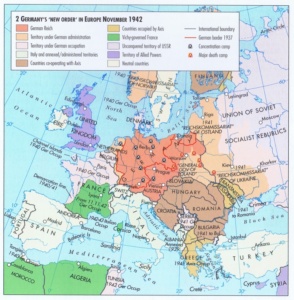
Germany’s influence in Europe as of November 1942
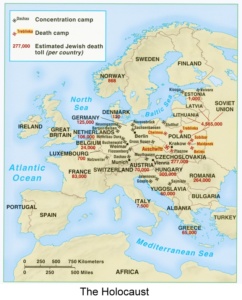
Distribution of Concentration Camps, Death Camps, and Jewish death toll throughout Europe
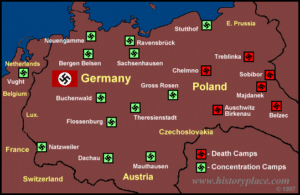
Resources
PBS Newshour Extra – News for students and teacher resources from grades 7-12.
United States Holocaust Memorial Museum – A living memorial to the Holocaust, with interactive online exhibits.
Center for Holocaust Awareness & Information (CHAI) – Part of the Jewish Fderation of Rochester, CHAI, meaning “life” works to ensure the Holocaust and it’s lessons are not forgotten.
Perilous Journeys – Web publication of stories of both peril and rescue during the Holocaust.
Holocaust Teacher Resource Center – Collection of teacher resources including Survivor videos, essays, and lesson plans.
Yad Vashem, The World Holocaust Rememberance Center – Includes digital collections, archives, educator resources, and lesson plans.
State of Florida Task Force on Holocaust Education
The Jewish Foundation for the Righteous
Holocaust Documentation Center in Hollywood
The Holocaust Memorial, Miami Beach
UCL Centre for Holocaust Education
Holocaust Museum and Learning Center – A department of the Jewish Federation of St Louis. Online resource includes oral histories, recommended readings, films, and educator resources.
